Guinea-Bissau |
|
|
|
| Übersicht – Contents: | |
Guinea-Bissau |
|
|
|
| Übersicht – Contents: | |
Flagge – Flag: |
|
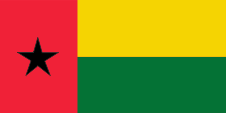 |
Nationalflagge – national flag, Seitenverhältnis – ratio = 1:2, Quelle/Source: Corel Draw 4 |
historische Flaggen – historical Flags: |
|
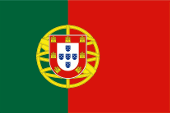 |
1911–1973,  |
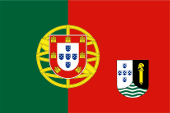 |
60-er Jahre 19. Jhd. / sixties of the 19th cent., |
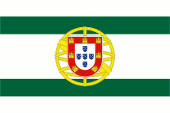 |
bis/to 1935, Flagge eines Oberkommissars – flag of a High Commissioner, Seitenverhältnis – ratio = 2:3, Quelle/Source, nach/by: Flaggenbuch 1939 |
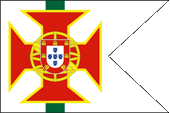 |
1935–1961, Flagge eines Distriktskommandanten – flag of a District Commandant, Seitenverhältnis – ratio = 2:3, Quelle/Source, nach/by: Flaggenbuch 1939 |
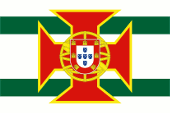 |
1935–1973, Flagge des Generalgouverneurs – flag of the Governor General, Seitenverhältnis – ratio = 2:3, Quelle/Source: Die Welt im bunten Flaggenbild |
Bedeutung/Ursprung der Flagge – Meaning/Origin of the Flag: |
|
| Die heutige Flagge von Guinea-Bissau wurde am 24.09.1973 im Zusammenhang mit der Erklärung der Unabhängigkeit eingeführt. Sie zeigt zwei waagerechte Streifen in Gelb und Grün, und am Mast einen senkrechter Streifen in Rot, darauf einen schwarzen fünfstrahligen Stern. Dieser Stern ist das Symbol für Afrika und und seine schwarze Bevölkerung, er ist unmittelbar von der Flagge Ghanas abgeleitet. Diese Flagge entspricht (bis auf die fehlenden Initialen) der im Jahre 1961 eingeführten Flagge der PAIGC-Partei. Die Farbe Rot steht für das im Freiheitskampf vergossene Blut, Gelb für die Sonne und die Bodenschätze des Landes, Grün für die Vegetation und die Landwirtschaft. Die Farben sind wie folgt definiert: Rot = Pantone 032, Gelb = Pantone 109, Grün = Pantone 355. | The
today's flag of Guinea-Bissau was inroduced on the 24th of september in
1973 in context with the declaration of independence. It shows two
horizontal stripes in yellow and green and near the pole a vertical stripe
in red, thereupon a black five-jagged star. These star is the symbol for
Africa and it's black population, he is directly derived from the flag of
Ghana. This flag corresponds (except the lacking initials) to the in the year 1961 introduced flag of the PAIGC-party. The colour red stands for the in the fight for freedom given blood, yellow stands for the sun and the natural resources of the country, green stands for the vegetation and the agriculture. The colors are defined as follows: red = Pantone 032, yellow = Pantone 109, green = Pantone 355. |
| Die Farbkombination von Grün, Gelb und Rot in der heutigen Flagge sind die Panafrikanischen Farben: Etwa 1900 setzte die Panafrika - Bewegung ein, die Gemeinsamkeiten aller Menschen mit schwarzer Hautfarbe hervorheben wollte. Für die politische Einheit Afrikas steht der Farbendreiklang Grün-Gelb-Rot, den viele afrikanische Staaten nach Erlangung ihrer Unabhängigkeit in ihre Flaggen übernahmen. Das erste Land war Ghana im Jahr 1957. Als Ursprung gelten die Landesfarben von Athiopien (Abessinien, dem ältesten unabhängigen Staat Afrikas. | The
combination of the colours green, yellow and red in the today's flag are the
Pan-African colours: Perhaps in 1900 was the beginning of the
Panafrica-Movement, wich wants to emphasize the commons of all people with
black skin. For the political unity of Africa stands the colour-triad
green-yellow-red, wich used many african countries in their flags after the
independence. The first country was Ghana in 1957. As the origin apply the
colours of Ethiopia (Abessinia), the oldest independent state in Africa. |
| In der Zeit als portugiesische Kolonie wurde ausschließlich die portugiesische Nationalflagge verwendet, da man die Kolonien als fester Bestandteil des Mutterlandes betrachtete, und nicht als Außenbesitzungen. Das bedeutete, das portugiesische Kolonien nie eigene Flaggen hatten, auch wenn es in den sechziger Jahren des 20. Jahrhunderts Bestrebungen gab Flaggen für die Kolonien einzuführen, indem man das Wappen der Kolonie in das fliegende Ende der portugiesischen Nationalflagge platzierte. Diese Pläne wurden jedoch nie realisiert. | In the
times of the Portugese colony was solely in use the Portugese national flag
because they saw the colonies as permanent component of the motherland and
not as outer possessions. This implys that Portugese
colonies never had own flags, even if there were ambitions in the sixties of
the 20th century to introduce flags for the colonies by placing of the coat
of arms of the colony in the flying end of the Portugese national flag. But
this plans became never realized. |
| Quelle/Source: Wikipedia (D), Die Welt der Flaggen, Flaggen Wappen Hymnen, Flaggen und Wappen der Welt, Flags of the World | |
Wappen – Coat of Arms: |
|
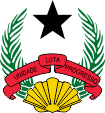 |
Wappen – coat of arms Quelle/Source: Corel Draw 4 |
 |
1935–1974, Wappen – coat of arms Quelle/Source: nach/by: Wikipedia (D) |
Bedeutung/Ursprung des Wappens – Meaning/Origin of the Coat of Arms: |
|
| Das Staatswappen von Guinea-Bissau wurde, wie die Flagge, im Jahre 1973 eingeführt. Es zeigt die pan-afrikanischen Farben und auch den auf der Flagge gezeigten schwarzen Stern. Im unteren Teil des Wappens ist eine goldene Muschel zu sehen. Sie steht für die Kapverdischen Inseln. Auf einem roten Band zwischen zwei grünen Palmzweigen (sie stehen für das Festland) der Staatswahlspruch: "Unidade, Luta, Progresso" → "Einigkeit, Kampf, Fortschritt". | The coat
of arms of Guinea-Bissau was - like the flag - introduced in the year 1973.
It shows the pan-african colours and even the on the flag shown black
star. In the below part of the coat of arms is to see a golden conch. It stands for the Cape Verde Islands. On a red saying-ribbon between two green palm-tree twigs (they stand for the mainland) the motto of the state: "Unidade, Luta, Progresso" → "Unity, Fight, Progress". |
| Im Jahre 1935 wurden für die portugiesischen Kolonien eigene Wappen eingeführt. Die Gestaltung unterlag einem gewissen Schema und so zeigte jedes Wappen neben einer lokalen Symbolik die fünf Quinas aus dem Wappen von Portugal und fünf grüne Wellen auf Silber. Als lokale Symbolik erschien im Wappen von Portugiesisch-Guinea ein schwarzes Feld mit dem goldenen Zepter von König Alfons V. | In the year 1935 own coats of arms were created for the Portuguese colonies. The design was subject to a special scheme. So each coat of arms contained, in addition to a local symbolism, the five Quinas from the coat of arms of Portugal and five green waves on silver. As the local symbolism in the coat of arms of Portuguese Guinea appeared a black field with the golden scepter of King Alfonso V. |
| Quelle/Source, nach/by: Wikipedia (D), Flaggen Wappen Hymnen, Flaggen und Wappen der Welt | |
Flugzeugkokarde – aircraft roundel: |
|
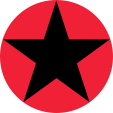 |
Flugzeugkokarde – aircraft roundel Quelle/Source, nach/by Wikipedia (EN) |
Landkarten – Maps: |
Lage – Position: |
Landkarte des Landes – Map of the Country: |
| Zahlen und Fakten – Numbers and Facts: | |
|
|
|
|
|
|
|
|
|
|
|
|
|
|
|
|
|
|
|
|
|
Geschichte: |
| 1446 · der Portugiese Nuño Tristão entdeckt und erforscht die Küste des
heutigen Guinea-Bissau 1460 · Gründung der portugiesischen Handelsstation Cacheu 1630 · Portugal erhebt Gebietsforderungen und dominiert den Handel an der Küste 1687 · Gründung der ersten portugiesischen Siedlung in der Nähe des heutigen Bissau 1765 · Gründung der Stadt São Joé des Bissau 1792 · britischer Siedlungsversuch bei Bolama scheitert 1879 · Gründung der Kolonie Portugiesisch-Guinea 1884 · Großbritannien und Frankreich errichten Handelsstützpunkte an der Küste 1885 · Berliner Konferenz: Portugiesisch-Guinea wird Portugal zugesprochen 1941 · Verlegung der Hauptstadt von Bolama nach Bissau 1951 · Portugiesisch-Guinea wird Überseeprovinz 1955 · Gewährung teilweiser innerer Autonomie 1956 · Gründung der linksextremistischen Befreiungsbewegung Partido Africano da Independencia de Guinea-Bissao e Cabo Verde (PAIGC) 1963 · Beginn des bewaffneten Kampfes der PAIGC gegen Portugal 24.09.1973 · die PAIGC erklärt einseitig Guinea-Bissaus Unabhängigkeit, Luis Cabral (PAIGC) wird Präsident 25.04.1974 · Revolte der portugiesischen Armee gegen die Regierung Caetano in Portugal 10.09.1974 · Portugal erkennt die Unabhängigkeit von Guinea-Bissau an 1980 · rassisch motivierter Staatsstreich von Major J. B. Vieira, Cabral wird gestürtzt 1981 · organisatorische Trennung der PAIGC, auf den Kapverden entsteht die PAICV 1984 · neue Verfassung, Vieira als Präsident bestätigt, die seit der Staatsgründung beabsichtigte Vereinigung mit den Kapverden wird für die Zukunft ausgeschlossen 1990 · Ansätze von Demokratisierung 1991 · Einführung des Mehrparteiensystems 1994 · Parlaments- und Präsidentschaftswahlen, absolute Mehrheit für PAIGC, Vieira als Präsident bestätigt 1998 · Armeerevolte, Bürgerkrieg 2010 · Putschversuch des Militärs 2012 · Militärputsch 2014 · Wahlen, in den Folgejahren unstabile Machtverhältnise |
History: |
| 1446 · the Portuguese Nuño Tristão discovers and explores the coast of
the today's Guinea-Bissau 1460 · foundation of the Portuguese merchant base Cacheu 1630 · Portugal claims territories and dominates the trade on the coast 1687 · foundation of the first Portuguese settlement near the today's Bissau 1765 · foundation of the town São Joé des Bissau 1792 · British settlement trial near Bolama fails 1879 · foundation of the Portuguese Guinea Colony 1884 · United Kingdom and France establish merchant stations on the coast 1885 · Berlin Conference: Portuguese Guinea gets adjudged to Portugal 1941 · transfer of the capital from Bolama to Bissau 1951 · Portuguese Guinea becomes an overseas province 1955 · granting of partial inner autonomy 1956 · foundation of the leftist extremistic liberation movement "Partido Africano da Independencia de Guinea-Bissao e Cabo Verde" (PAIGC) 1963 · start of the armed fight of the PAIGC against Portugal 24th of September in 1973 · the PAIGC declares unilaterally the independence of Guinea-Bissau, Luis Cabral (PAIGC) becomes president 25th of April in 1974 · revolt of the Portugese army against the government of Caetano in Portugal 10th of September in 1974 · Portugal recognizes the independence of Guinea-Bissau 1980 · racial motivated coup d'état by Major J. B. Vieira, Cabral gets unseated 1981 · organizational separation of the PAIGC, on the Cape Verde Islands arises the PAICV 1984 · new constitution, Vieira gets confirmed as president, the since the foundation of the state intended unification with the Cape Verde Islands becomes excluded for the future 1990 · initial stages of democratization 1991 · introduction of the multi-party-system 1994 · elections for parliament and president, absolute majority for the PAIGC, Vieira gets confirmed as president 1998 · army revolt, civil war 2010 · military coup attempt 2012 · military coup 2014 · elections, unstable power relations in the following years |
| Quelle/Source: Wikipedia (D), Atlas zur Geschichte, Weltgeschichte, Discovery '97 |
Ursprung des Landesnamens – Origin of the Country's Name: |
|
| Der Name "Guinea" geht auf das Berber-Wort "aguinaou" zurück, was "Schwarze" heißt und sich urspünglich auf alle Bewohner der Westafrikanischen Küste von Senegal bis Gabun bezog. | The name "Guinea" goes back to the Berber word "aguinaou", what means "blacks" and referred originally to all residents of the West African coast from Senegal to Gabon. |
| Der zweite Teil des Landesnamens, "Bissau", dient der Unterscheidung zu anderen Staaten die den namen "Guinea" tragen und bezieht sich auf die Haupstadt des Landes. | The second part of the country's name, "Bissau", helps to distinguish between other states which bear the name "Guinea" and refers to the capital of the country. |
| In der Zeit als portugiesische Kolonie hieß das Land Portugiesisch-Guinea. | In the time as a Portuguese colony, the country was called Portuguese Guinea. |
| Quelle/Source: Handbuch der geographischen Namen, Volker Preuß | |